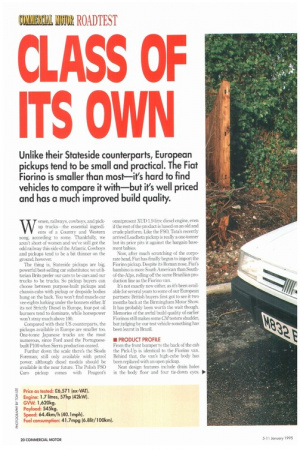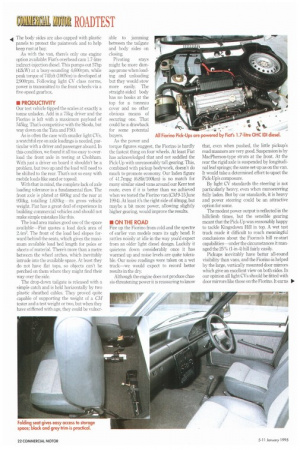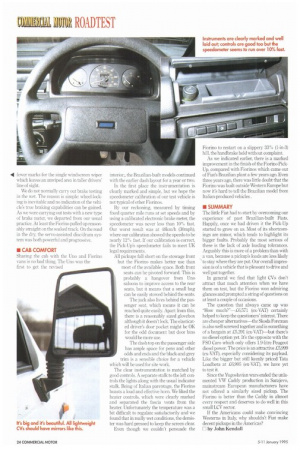CLASS OF ITS OWN
Page 22

Page 24

Page 26

If you've noticed an error in this article please click here to report it so we can fix it.
Unlike their Stateside counterparts, European pickups tend to be small and practical. The Fiat Fiorino is smaller than most—it's hard to find vehicles to compare it with—but it's well priced and has a much improved build quality.
Women, railways, cowboys, and pick up trucks the essential ingredients of a Country and Western song, according to some. Thankfully, we aren't short of women and we've still got the odd railway this side of the Atlantic. Cowboys and pickups tend to he a bit thinner on the ground, however,
The thing is, Stateside pickups are big, powerful best-selling car substitutes; we utilitarian Brits prefer our cars to be cars and our tucks to be trucks. So pickup buyers can choose between purpose-built pickups and chassis-cabs with pickup or dropside bodies hung on the back. You won't find muscle-car vee-eights lurking under the bonnets either. If its not Strictly Diesel in Europe, four-pot oil burners tend to dominate, while horsepower won't stray much above 100, Compared with their US counterparts, the pickups available in Europe are smaller too. One-tonne Japanese trucks are the most numerous, since Ford axed the Portuguesebuilt P100 when Sierra production ceased.
Further down the scale there's the Skala Foreman; still only available with petrol power, although diesel models should be available in the near future. The Polish FSO Caro pickup comes with Peugeot's omnipresent XJ. D 1.9-litre diesel engine, even if the rest of the product is based on an old and crude platform. Like the FSO, Tata's recently arrived Loadbeta pickup is really a one-tonner but its price pits it against the bargain basement babies.
Now, after much scratching of the corporate head, Fiat has finally begun to import the Fiorillo pickup. Despite its Roman nose, Fiat's bambino is more South American than Southof-the-Alps, rolling off the same Brazilian production line as the Fiorino van.
It's not exactly new either, as it's been available for several years to some of our European partners: British buyers first got to see it two months back at the Birmingham Motor Show. It has probably been worth the wait though. Memories of the awful build quality of earlier Fiorinos still makes some CM testers shudder, but judging by our test vehicle something has been learnt in Brazil.
• PRODUCT PROFILE From the front bumper to the back of the cab the Pick-Up is identical to the Fiorino van. Behind that, the van's high-cube body has been replaced with an open pickup.
Neat design features include drain holes in the body floor and four tie-down eyes II. The body sides are also capped with plastic panels to protect the paintwork and to help keep rust at bay As with the van, there's only one engine option available: Fiat's overhead cam 1.7-litre indirect-injection diesel. This pumps out 57hp (42kW) at a busy-sounding 4,600rpm, while peak torque of 741hft (100Nm) is developed at 2,900rpm. Following light CV class norms, power is transmitted to the front wheels via a five-speed gearbox.
• PRODUCTIVITY
Our test vehicle tipped the scales at exactly a tonne unladen. Add in a 75kg driver and the Fiorino is left with a maximum payload of 545kg. That's competitive with the Skoda, but way down on the Tata and FSO.
As is often the case with smaller light CVs, a watchful eye on axle loadings is needed, particular with a driver and passenger aboard. In this condition, we found it all too easy to overload the front axle in testing at Chobham. With just a driver on board it shouldn't be a problem, but two up and the load will need to be shifted to the rear. That's not so easy with mobile loads like sand or topsoil.
With that in mind, the complete lack of axle loading tolerance is a fundamental flaw. The front axle is plated at 690kg and the rear at 930kg. totalling 1,620kg—its gross vehicle weight. Fiat has a great deal of experience in building commercial vehicles and should not make simple mistakes like this.
The load area makes good use of the space available—Fiat quotes a load deck area of 2.4m2. The front of the load bed slopes forward behind the seats, which gives the maximum available load bed length for poles or sheets of material. There's more than a metre between the wheel arches, which inevitably intrude into the available space. At least they do not have flat tops, so objects can't be perched on them where they might find their way over the side.
The drop-down tailgate is released with a simple catch and is held horizontally by two plastic sheathed cables. They proved quite capable of supporting the weight of a CM tester and a test weight or two, but when they have stiffened with age, they could be vulner
able to jamming between the tailgate and body sides on closing.
Pivoting stays might be more damage prone when loading and unloading but they would stow more easily. The straight-sided body has no hooks at the top for a tonneau cover and no other obvious means of securing one. That could be a drawback for some potential buyers.
As the power and torque figures suggest, the Fiorino is hardly the fastest thing on four wheels. At least Fiat has acknowledged that and not saddled the Pick-Up with unreasonably tall gearing. This, combined with pickup bodywork, doesn't do much to promote economy. Our laden figure of 41.7mpg (6.81it/100km) is no match for many similar sized vans around our Kent test route, even if it is better than we achieved when we tested the Fiorino van (CM9-15 June 1994). At least it's the right side of 40mpg, but maybe a bit more power, allowing slightly higher gearing, would improve the results.
• ON THE ROAD
Fire up the Fiorino from cold and the spectre of earlier van models rears its ugly head. It rattles noisily at idle in the way you'd expect from an older light diesel design. Luckily it quietens down considerably once it has warmed up and noise levels are quite tolerable. Our noise readings were taken on a wet track—we would expect to record better results in the dry.
Although the engine does not produce chassis-threatening power it is reassuring to know that, even when pushed, the little pickup's road manners are very good. Suspension is by MacPherson-type struts at the front. At the rear the rigid axle is suspended by longitudinal leaf springs; the same set-up as on the van. It would take a determined effort to upset the Pick-Up's composure, By light CV standards the steering is not particularly heavy, even when manoeuvring fully laden. But by car standards, it is heavy and power steering could be an attractive option for some.
The modest power output is reflected in the hillclimb times, but the sensible gearing meant that the Pick-Up was reasonably happy to tackle Kingsdown Hill in top. A wet test track made it difficult to reach meaningful conclusions about the Fiorino's hill re-start capabilities—under the circumstances it managed the 25% (1.in-4) hill fairly easily
Pickups inevitably have better all-round visibility than vans, and the Fiorino is helped by the large, vertically mounted door minors which give an excellent view on both sides. In our opinion all light CVs should be fitted with door mirrors like those on the Fiorino. It earns OP'
fewer marks for the single windscreen wiper which leaves an unwiped area in taller drivers' line of sight We do not normally awry out brake testing in the wet. The reason is simple: wheel-locking is inevitable and no indication of the vehicle's true braking capabilities can be gained. As we were carrying out tests with a new type of brake meter, we departed from our usual practice. At least the Morino pulled up reasonably straight on the soaked track. On the road in the dr the servo-assisted disc/drum system was both powerful and progressive.
• CAB COMFORT Sharing the cab with the Uno and Fiorino vans is no had thing. The Uno was the first to get the revised interior;, the Brazilian-built models continued with the earlier dash layout for a year or two.
In the first place the instrumentation is clearly marked and simple, but we hope the speedometer calibration of our test vehicle is not typical of other Fiorinos.
By our reckoning, measured by timing fixed quarter mile runs at set speeds and by using a calibrated electronic brake meter the speedometer was never less than 10% fast. Our worst result was at 48km/h (30mpb), where our calibration showed the speedo to be nearly 12% fast. If our calibration is correct, the Pick-Up's speedometer fails to meet UK legal requirements.
All pickups fall short on the stowage front but the Fiorino makes better use than most of the available space. Both front seats can be pivoted forvvard. This is probably a hangover from Uno saloons to improve access to the rear seats, but it means that a small bag can be easily stowed behind the seats.
The jack also Eves behind the passenger seat, which means it can be reached quite easily. Apart from this, there is a reasonably sized glovebox although it doesn't lock. The elasticated driver's door pocket might be OK for the odd document but door bins would be more use.
The dash top on the passenger side has ample space for pens and other odds and ends and the black-and-grey trim is a sensible choice for a vehicle which will be used for site work.
The clear instrumentation is matched by good controls. A separate stalk to the left controls the lights along with the usual indicator stalk. Being of Italian parentage, the Fiorino boasts a loud and effective horn. We liked the heater controls, which were clearly marked and separated the fascia vents from the heater. Unfortunately the temperature was a bit difficult to regulate satisfactorily and we found that in really wet conditions, the demister was hard pressed to keep the screen clear.
Even though we couldn't persuade the Fiorino to restart on a slippery 33% (1-in-3) hill, the handbrake held without complaint.
As we indicated earlier, there is a marked improvement in the finish of the Fiorino PickUp. compared with Fiorinas which came out of Fiat's Brazilian plant a few years ago. Even three years ago, there was little doubt that the Fiorino was built outside Western Europe but now it's hard to tell the Brazilian model from Italian-produced vehicles.
II SUMMARY
The little Fiat had to start by overcoming our experience of past Brazilian-built Fiats. Happily, once we had driven it the Pick-Up started to grow on us. Most of its shortcomings are minor, which tends to highlight its bigger faults. Probably the most serious of these is the lack of axle loading tolerances. Arguably this is more of a problem than with a van, because a pickup's loads are less likely 'to stay where they are put. Our overall impression is of a vehicle that is pleasant to drive and well put together.
In general we find that light CVs don't attract that much attention when we have them on test, but the Fiorino won admiring glances and prompted a string of questions on at least a couple of occasions.
The question that always came up was "How much?"—,0,571 (ex-VAT) certainly helped to keep the questioners interest. There are cheaper alternatives—the Skoda Foreman is also well screwed together and is something of a bargain at £5,391 (ex-VAT)—but there's no diesel option yet. It's the opposite with the FS0 Cam which only offers 1.9-litre Peugeot diesel power. The price is an attractive £5,999 (ex-VAT), especially considering its payload. Like the bigger but still keenly priced Tata Loadbeta at .0,995 (ex-VAT), we have yet to test it.
Since the Yugoslavian wars ended the unlatnented VW Caddy production in Sarajevo, mainstream European manufacturers have not offered a similarly sized pickup. The Morino is better than the Caddy in almost every respect and deserves to do well in this small LCV sector.
If the Americans could make convincing Westerns in Italy, why shouldn't Fiat make decent pickups in the Americas?
rl by John Kendall












































































